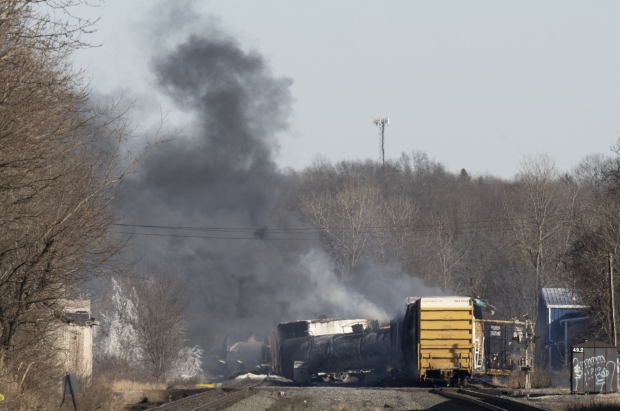Months-Long Lingering Of Toxic Chemicals After Ohio Train Derailment

Table of Contents
The Initial Impact and Immediate Aftermath of the Ohio Train Derailment
On February 3, 2023, a Norfolk Southern freight train derailed in East Palestine, Ohio, resulting in a catastrophic release of toxic chemicals. The accident involved the spillage of vinyl chloride, butyl acrylate, and other hazardous substances, creating an immediate environmental and public health emergency. The initial emergency response, while swift, faced significant limitations in effectively containing the spread of the chemicals and protecting residents.
- Scale of the chemical spill: The derailment involved approximately 50 cars, with several carrying hazardous materials. The sheer volume of released chemicals contaminated a wide area.
- Immediate environmental contamination (soil, water, air): Soil, water sources like the Ohio River and Leslie Run, and the air were immediately contaminated, raising concerns about long-term ecological damage.
- Initial health concerns reported by residents: Residents reported immediate health problems, including respiratory irritation, headaches, and nausea, following the controlled burn of vinyl chloride.
- Criticisms of the initial response: The initial response faced criticism for its perceived lack of transparency and communication with the affected community, raising concerns about the adequacy of safety protocols and environmental protection measures. The decision to conduct a controlled burn of vinyl chloride, releasing potentially harmful byproducts, sparked intense debate.
Long-Term Health Concerns from Exposure to Toxic Chemicals
Exposure to the toxic chemicals released during the Ohio train derailment poses significant long-term health risks to the affected population. The specific chemicals involved, such as vinyl chloride and butyl acrylate, are known carcinogens and can cause a range of acute and chronic health problems.
- Respiratory problems (asthma, bronchitis): Exposure to these chemicals can exacerbate existing respiratory conditions and cause new ones, including asthma and bronchitis.
- Reproductive issues: Studies have linked exposure to vinyl chloride and other similar chemicals to reproductive problems in both men and women.
- Cancer risks: Many of the spilled chemicals are known or suspected carcinogens, increasing the risk of various cancers over time.
- Neurological effects: Some of these chemicals can affect the nervous system, leading to neurological problems ranging from headaches and dizziness to more serious cognitive impairments.
- Developmental issues (in children): Prenatal and early childhood exposure to these toxic substances can lead to severe developmental problems in children.
- Need for ongoing health monitoring of affected communities: Long-term health monitoring programs are crucial to track the incidence of health problems among those exposed to the Ohio train derailment toxic chemicals. This requires comprehensive data collection and analysis.
Environmental Contamination and its Lasting Effects
The environmental contamination resulting from the Ohio train derailment is extensive and presents substantial challenges for cleanup and remediation. The long-term effects on the ecosystem are still unfolding.
- Soil testing results and contamination levels: Soil testing has revealed widespread contamination with various toxic chemicals, necessitating extensive and costly remediation efforts.
- Water contamination in nearby rivers and streams: The Ohio River and smaller waterways have been affected, raising concerns about the long-term impacts on aquatic life and drinking water sources.
- Air quality monitoring data: Air quality monitoring has shown elevated levels of pollutants in the immediate aftermath, though levels have generally subsided. Continued monitoring is essential.
- Long-term environmental impact assessment challenges: Assessing the full extent of the environmental damage and predicting the long-term impacts will be a complex and lengthy process.
- The potential for bioaccumulation of toxins in the food chain: The potential for bioaccumulation of toxins in the food chain presents an additional concern, potentially affecting human health through the consumption of contaminated plants and animals.
Government Response and Accountability Following the Ohio Train Derailment
The governmental response to the Ohio train derailment has been a subject of intense scrutiny and debate. While federal and state agencies were involved, criticism has focused on the perceived lack of transparency, insufficient communication, and slow response to the crisis.
- Federal and state agency involvement: The EPA, along with Ohio's environmental protection agency, have been heavily involved in the cleanup and investigation.
- Investigations into the cause of the derailment: Investigations are ongoing to determine the precise causes of the derailment and to identify areas for improvement in railway safety regulations.
- Legal actions and lawsuits filed: Numerous lawsuits have been filed against Norfolk Southern and other entities involved, seeking compensation for damages and holding responsible parties accountable.
- Regulatory changes proposed or implemented: The disaster has prompted calls for stricter regulations on the transportation of hazardous materials by rail and improvements in emergency response protocols.
- Governmental transparency and communication with the affected communities: Improved communication and transparency are crucial to rebuilding trust and ensuring the ongoing safety and well-being of the affected communities.
The Role of the Norfolk Southern Railway Company
Norfolk Southern, as the operator of the train, bears significant responsibility for the Ohio train derailment and its aftermath. The company's response has been criticized for its handling of the cleanup, communication with residents, and financial compensation.
- Cleanup efforts and their effectiveness: The effectiveness of Norfolk Southern's cleanup efforts remains a point of contention, with concerns raised about the thoroughness and long-term impact.
- Company’s communication with affected communities: The company's communication with the affected communities has been criticized for a lack of transparency and responsiveness.
- Financial compensation and support provided: The level of financial compensation and support provided by Norfolk Southern to affected individuals and communities continues to be a major area of dispute.
- Public perception and criticism of Norfolk Southern’s response: Public perception of Norfolk Southern's response has been largely negative, with widespread criticism of the company's handling of the crisis.
Conclusion
The Ohio train derailment and the subsequent release of toxic chemicals represent a significant environmental and public health disaster with far-reaching consequences. Months after the event, the lingering effects continue to pose serious risks, demanding immediate and comprehensive action. The long-term health impacts, environmental contamination, and the need for robust governmental oversight cannot be ignored. The ongoing investigation into the lingering effects of the Ohio train derailment toxic chemicals is paramount. We must demand accountability from all responsible parties and ensure long-term monitoring and support for affected communities. Further investigation into the Ohio train derailment toxic chemicals is crucial to mitigate the ongoing risks and prevent future tragedies. Stay informed, advocate for change, and demand a thorough and transparent response to this devastating event.

Featured Posts
-
 Weak Retail Sales Signal Potential Bank Of Canada Rate Cuts
Apr 28, 2025
Weak Retail Sales Signal Potential Bank Of Canada Rate Cuts
Apr 28, 2025 -
 23 Xi Racing Announces New Sponsor For Bubba Wallace
Apr 28, 2025
23 Xi Racing Announces New Sponsor For Bubba Wallace
Apr 28, 2025 -
 Mets Rival A Pitchers Unbeatable Season
Apr 28, 2025
Mets Rival A Pitchers Unbeatable Season
Apr 28, 2025 -
 Cybercriminal Makes Millions Exploiting Office365 Executive Accounts
Apr 28, 2025
Cybercriminal Makes Millions Exploiting Office365 Executive Accounts
Apr 28, 2025 -
 Aaron Judges Wife Samantha Gives Birth Couple Reveals Babys Name And Photo
Apr 28, 2025
Aaron Judges Wife Samantha Gives Birth Couple Reveals Babys Name And Photo
Apr 28, 2025
Latest Posts
-
 Ohio Train Derailment The Long Term Impact Of Lingering Toxic Chemicals
May 11, 2025
Ohio Train Derailment The Long Term Impact Of Lingering Toxic Chemicals
May 11, 2025 -
 East Palestine Toxic Chemical Exposure Lingering Contamination In Buildings
May 11, 2025
East Palestine Toxic Chemical Exposure Lingering Contamination In Buildings
May 11, 2025 -
 Cybercriminals Office365 Breaches Result In Multi Million Dollar Losses
May 11, 2025
Cybercriminals Office365 Breaches Result In Multi Million Dollar Losses
May 11, 2025 -
 Federal Investigation Crook Made Millions From Executive Office365 Inboxes
May 11, 2025
Federal Investigation Crook Made Millions From Executive Office365 Inboxes
May 11, 2025 -
 Millions Stolen After Cybercriminal Targets Executive Office365 Accounts
May 11, 2025
Millions Stolen After Cybercriminal Targets Executive Office365 Accounts
May 11, 2025
